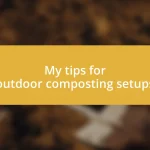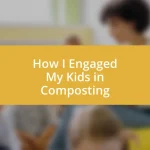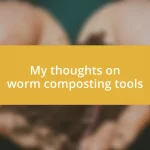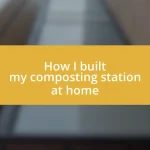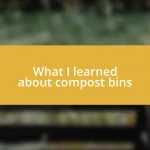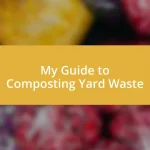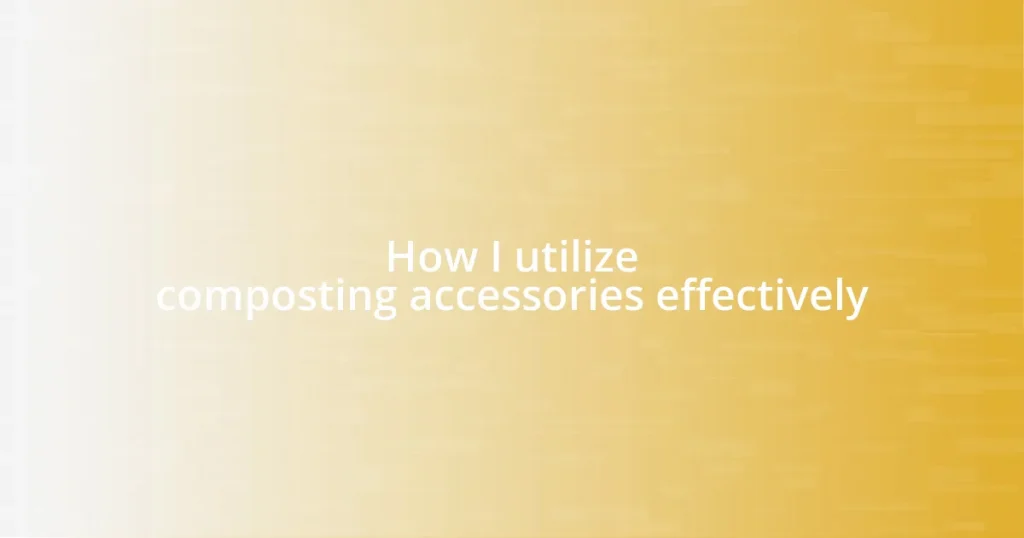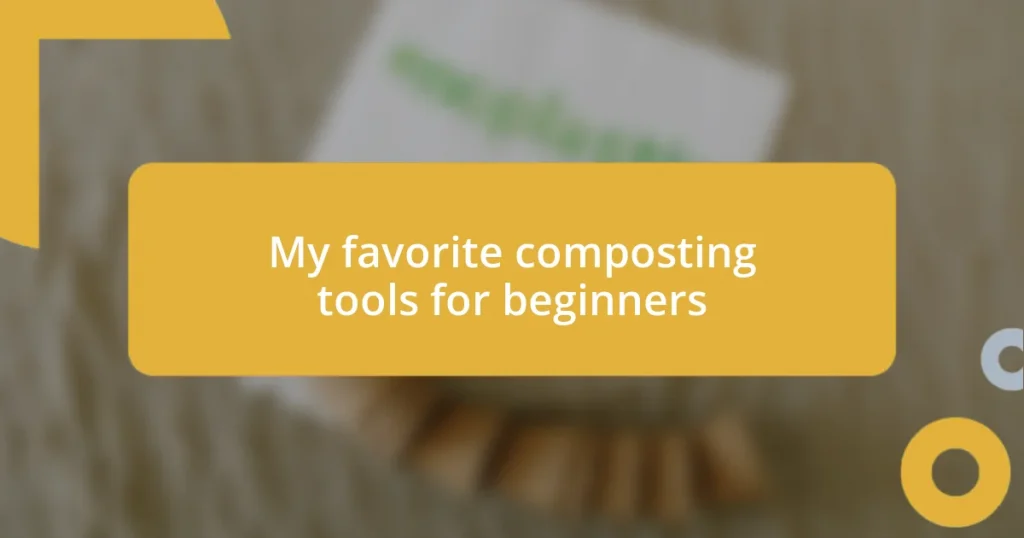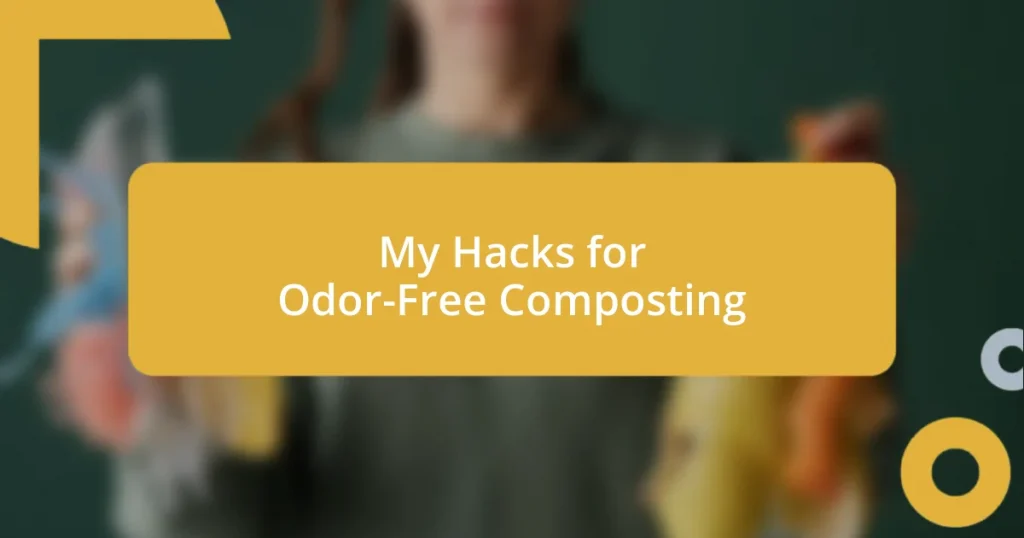Key takeaways:
- The author’s indoor composting journey started with excitement but included challenges such as managing fruit flies and balancing green and brown materials for nutrient-rich compost.
- Indoor composting significantly reduces waste, improves plant health, and serves as an educational tool for promoting sustainability among friends and family.
- Successful composting requires maintaining balance, chopping scraps for quicker decomposition, and addressing common issues like odors and moisture levels.

My indoor composting journey
Beginning my indoor composting journey was both exciting and a bit daunting. I vividly remember the first time I set up my compost bin—my kitchen was suddenly filled with the scent of fresh herbs and the anticipation of turning kitchen scraps into liquid gold for my plants. Have you ever felt that rush of enthusiasm when starting something new? It’s exhilarating, isn’t it?
As I got the hang of things, I encountered a few hurdles, like those pesky fruit flies. Initially, it felt overwhelming, but I realized each challenge taught me something valuable. For instance, discovering the magic of browns and greens in my compost—who knew that balancing carbon-rich materials like dried leaves with nitrogen-packed scraps could create such a beautiful, nutrient-rich mixture? It’s fascinating how a simple bin can transform everyday waste into a vibrant ecosystem.
Over time, I grew more attuned to the process. I began to see composting not just as a chore but as a closer connection to nature, even within my small apartment. I still recall that first handful of rich, dark compost I harvested. It felt like winning a tiny victory over waste. Isn’t it incredible how something we used to discard can turn into life for our plants? That’s the beauty of indoor composting—it truly changed my perspective on waste and sustainability.

Benefits of indoor composting
The benefits of indoor composting are numerous, and I can’t help but feel excited when I think about how it has transformed my living space. One notable advantage is waste reduction; I’ve seen a significant decrease in the amount of trash I generate. It’s liberating to know that my food scraps are being repurposed instead of contributing to a landfill. Hasn’t anyone ever wondered what could happen if we all made a little effort to reduce our waste? It’s empowering!
Indoor composting also brings a touch of green into my home—literally and figuratively. I was surprised at how rapidly my houseplants thrived after I started adding homemade compost to their soil. The differences were almost instantaneous! Unlimited nutrients right at my fingertips? It felt like I had unlocked a secret weapon for plant health. Sharing this experience with my friends, I constantly encourage them to try composting, too. Who doesn’t want lush, vibrant plants?
Moreover, indoor composting provides an unique opportunity to educate family and friends about sustainability. Whenever someone visits my home, the compost bin intrigues them. It opens up discussions on how small changes can lead to a significant impact on our environment. I remember sharing my success stories and seeing the spark of interest in their eyes—what a joy it is to inspire others! Now, we can collectively work towards a greener planet, one compost bin at a time.
| Benefits | Description |
|---|---|
| Waste Reduction | Decreases the amount of kitchen waste heading to landfills. |
| Nutrient-Rich Soil | Provides houseplants with natural fertilizers for better growth. |
| Educational Opportunity | Encourages conversations about sustainability among friends and family. |

Choosing the right composting system
Choosing the right composting system can feel overwhelming at first, but it’s essential for a successful indoor composting experience. I remember standing in the local gardening store, surrounded by various options—from tumblers to worm bins. Each one had its own charm, yet I had to consider my living space and lifestyle. I opted for a compact countertop bin that seemed perfect for my tiny kitchen. The right system should fit seamlessly into your home and routine, allowing for an enjoyable composting journey.
Here are some key factors to consider when selecting your system:
- Space Requirements: Assess how much room you have and whether you prefer a stationary or portable system.
- Material Type: Consider whether you want a traditional bin, a worm composting system, or a bokashi method, which ferments waste.
- Maintenance Needs: Some systems require less upkeep; ensure you choose one that suits your level of commitment.
- Odor Control: Look for bins with good sealing to keep unpleasant smells at bay, an essential factor in smaller spaces.
- Aesthetic Appeal: If it’s in your kitchen, a visually pleasing design might encourage more regular use.
Ultimately, I found that the best system is one that fits your lifestyle and makes composting feel less like a chore and more like an exciting part of daily life.

Recommended indoor composting methods
When it comes to indoor composting methods, I’ve had great luck with worm bins. These systems, often referred to as vermicomposting, utilize red wiggler worms to break down food scraps. I remember the first time I opened my worm bin, and it felt like unveiling a hidden treasure! Those little wrigglers turned my kitchen waste into nutrient-rich compost while requiring very little maintenance. Isn’t it fascinating how nature can do such remarkable work?
Another option that I found intriguing is the bokashi method. I was skeptical at first, but this fermentation process truly impressed me. With bokashi, you add kitchen scraps to a special bucket and sprinkle it with a bran mixture that ferments the waste. The smell during fermentation isn’t unpleasant—more like a tangy pickle! I discovered that once the process is complete, you can bury the contents in a garden or add it to another compost pile. What a creative way to speed up composting in your indoor space!
If you prefer something straightforward, a countertop compost bin might be the right choice for you. These are typically compact and make collecting scraps easy, perfect if you’re like me and always on the go. I simply toss my vegetable peels and coffee grounds in and empty it into my larger compost system once a week. There’s a certain satisfaction in seeing the bin fill up, knowing I’m contributing to a sustainable cycle. Have you ever thought about how simple actions can lead to significant change? Each method has its own unique charm, and I encourage you to explore what resonates with you!

Tips for successful indoor composting
I’m excited to share some tips from my journey with indoor composting! One key aspect I learned is to keep your compost balanced. Incorporating a mix of “green” materials (like fruit scraps and coffee grounds) and “brown” materials (like dried leaves or shredded paper) is essential. I recall when I overloaded my bin with kitchen scraps; the smell was awful! Once I started adding more browns, the balance improved significantly. Have you ever noticed how adding just a bit of carbon-rich material can transform your composting experience?
Another practical tip is to chop your scraps into smaller pieces. I found that doing this not only sped up the decomposition process but also helped keep my bin aerated. The first time I threw in whole apple cores, I was disappointed to find them still intact weeks later. Now, with my trusty knife, I find it’s so much more satisfying to see things break down quickly. It’s amazing how little efforts can lead to big changes, isn’t it?
Lastly, don’t forget to stir your compost regularly! I’ve personally found that turning the contents helps with airflow and speeds up decomposition. I remember the day I got my hands dirty, mixing everything up, and immediately noticing the rich, earthy smell that followed. It felt like I was nurturing a little ecosystem right in my kitchen. Do you think adding your personal touch to composting makes it feel more rewarding? It sure does for me!

Troubleshooting indoor composting issues
Sometimes, indoor composting doesn’t go as smoothly as we hope. I recall a time when I noticed fruit flies buzzing around my kitchen. It was maddening! I learned that sealing my compost bin tightly and using a carbon-rich layer, like shredded newspaper, helped keep those pesky critters at bay. Have you ever experienced an unexpected guest in your composting journey?
Another common issue is unwanted odors. There was a moment when the smell from my bin made it feel more like a science experiment gone wrong than a sustainable practice. I quickly realized that adding dried leaves and keeping the right balance between greens and browns was my best strategy. It’s remarkable how a little attention can transform an unpleasant scent into that delightful, earthy aroma we associate with thriving compost, don’t you think?
Lastly, the moisture content can be tricky. I remember the frustration of a soggy compost bin; I had to fish out mushy food scraps that just wouldn’t break down. Adjusting my approach to include drier materials and ensuring proper drainage always worked wonders. Have you ever faced an issue where a slight adjustment made all the difference in your composting experience? It’s these small lessons that really deepen my appreciation for sustainable practices.

Harvesting and using compost indoors
Harvesting compost from my indoor system always fills me with a sense of accomplishment. When the compost looks dark and crumbly, I know it’s time. I remember the first time I sifted through my bin and uncovered rich black gold; I was ecstatic! I quickly collected it in a bucket, feeling like I had just unearthed treasure. Have you ever felt that rush of joy when your efforts yield something so valuable?
Using my compost is just as exciting. I’ve sprinkled it on my indoor plants, and I can truly tell the difference in their growth. This past spring, I applied some to my potted basil, and it flourished like never before. The vibrant green leaves beckoned to me, promising fresh pesto nights. I often wonder, how does something so simple – just decomposed food scraps – have such a profound impact on my plants?
As I incorporate my indoor compost into the soil, I also relish the idea of sustainability. Knowing that I’m diverting waste from landfills while nurturing my home garden makes the whole indoor composting journey so fulfilling. I once stood in my kitchen, mixing compost into potting soil, reminiscing about my journey from compost novice to seasoned gardener. Isn’t it wonderful how a small choice can lead to such meaningful change?



